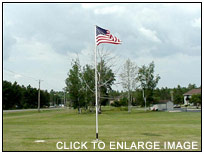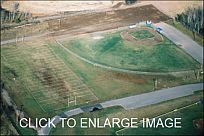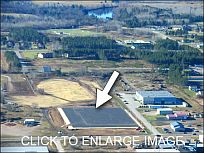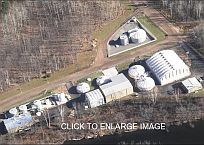










|
Ford Motor Company and The Kingsford Products Company (Ford and Kingsford Products) have undertaken extensive investigations of soil and groundwater conditions at the Kingsford Site, which generally is bordered on the north by Woodward Avenue, on the east by Hooper Street, and on the west and south by the Menominee River. Information and results of the investigation activities have been provided to the Michigan Department of Environment, Great Lakes, and Energy (EGLE).
Click here for a map of the Kingsford Site.
Investigations at the Kingsford Site have determined that naturally occurring bacteria in the subsurface break down organic materials, both naturally occurring carbon products and anthropogenic products (derived from human activities), in deep groundwater and generate gas-phase methane. The gas-phase methane formed by these natural processes is initially contained in the deep groundwater as dissolved-phase methane. Because of variations in the geology below the ground surface, groundwater flow, and differences in pressure, under certain conditions methane dissolved in the groundwater can move out of the groundwater into soil below the ground surface as a vapor (gas-phase methane). Underground silt/clay layers can trap gas-phase methane (if present) in sand below ground and prevent it from coming to ground surface. However, where there are openings in the underground silt/clay layers, gas-phase methane can move to the ground surface. Ford and Kingsford Products are using active and passive venting methods to remove and control gas-phase methane (where present) below the ground surface.
Both the active and passive vents are routinely monitored, and have been successful at eliminating potential safety risks due to gas-phase methane.
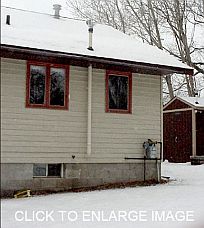
As part of the methane programs, vapor control systems have been designed and installed on appropriate structures to minimize the potential for sub surface gas-phase methane to accumulate beneath the structure. Vapor control systems are a preventative measure and an additional safety factor in addressing environmental conditions in the Kingsford Study Area portion, which is the portion of the Kingsford Site where the residential and commercial programs are implemented. Click here for a map of the Kingsford Study AreaFree installation of a vapor control system, including a building inspection and sealing of cracks or openings in the lowest level of the structure, is part of the long-term environmental response and monitoring activities in the Kingsford Study Area. 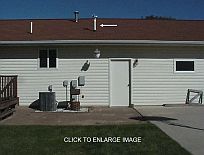 The standard vapor control system consists of a three-inch diameter PVC pipe or equivalent, extending through the floor slab of the lowest level of the structure. The pipe is sealed where it comes through the floor and either runs to the outside of the structure through the basement wall or through the interior of the structure and exits through the roof. The top of the pipe, above the roof, is fitted with either a 4-inch wind turbine or rain cap.
The standard vapor control system consists of a three-inch diameter PVC pipe or equivalent, extending through the floor slab of the lowest level of the structure. The pipe is sealed where it comes through the floor and either runs to the outside of the structure through the basement wall or through the interior of the structure and exits through the roof. The top of the pipe, above the roof, is fitted with either a 4-inch wind turbine or rain cap.
For structures with a crawl space or dirt floor, the standard design is to place and seal a layer of polyethylene sheeting across the crawl space or dirt floor and install the pipe beneath it. The pipe is sealed where it comes through the sheeting and is routed to the outside as described above. Arcadis designs the systems in cooperation with the property owner to minimize the appearance of the vapor control system as much as possible. This includes activities such as painting the pipe to match the color of the house and working with the owner to determine the best placement for the system piping. Arcadis continues to work with residents and business owners to design and install vapor control systems in structures throughout the Kingsford Study Area. Historically across the Kingsford Site, 98 percent of residences have been inspected, and 85 percent have allowed the installation of a vapor control system. Inspections were completed on all commercial properties and 92 percent have allowed the installation of a vapor control system. Inspections are now completed for new residents or by request. In September 1997, the U.S. Environmental Protection Agency and EGLE initiated a methane detector program within Kingsford and in a portion of Breitung Township. Ford and Kingsford Products assumed control in 1998 and greatly expanded and enhanced the program over time. Methane detectors are designed to sound long before a potential safety hazard could develop, and are similar in function to smoke detectors. Methane detectors were distributed to the City of Kingsford and Breitung Township residents located within the Kingsford Site. As of January 2017, if a VCS has been installed in your home to prevent any potential gas accumulation and entry, maintaining a methane detector is no longer required by EGLE. If you currently do not have a VCS installed and live within the Kingsford Study Area, it is our recommendation that a methane detector be maintained in your home as an additional level of safety until a preventative vapor control system can be installed. If you have any questions about the methane programs or activities related to the Kingsford Study Area, please call the local Arcadis office at 906.776.0853.Should your methane detector sound, we urge you to call 911 from a neighbor's house or outside with a cell phone as a safety precaution. Click here to view A Homeowner's Guide to Minimizing Potential Vapor Entry. Click here to view the Understanding Vapor Control System Pamphlet. Click here to view the Methane Detector Owner's Manual. Click here to view photos of the Vapor Control Systems Click here to view photos of the Methane Program Activities
Previous investigations in the Kingsford Site have identified and evaluated several former disposal locations: Click here to view a map of the Former Diposal Areas
Activities completed at the RDA included:
EGLE has determined that these completed activities are an appropriate response for the RDA. Click here to view the Former Riverside Disposal Area IRAP. Click here to view photos of the Former Riverside Disposal Area
Environmental response activities that were completed for the Lodal Park/SW Pit area included removal and disposal of select waste materials, building up the existing soil cover to ensure a minimum of 30 inches of clean soil and installing/improving storm water drainage and controls. EGLE has determined that the activities completed are an appropriate response for the Lodal Park/SW Pit. Click here to view the Lodal Park/Former Southwest Pit IRAP.
Click here to view photos of Lodal Park/Former Southwest Pit
The NE Pit is an area west of the former manufacturing facility where organic liquids and solids from the historic wood processing operations were disposed in a former natural depression. Ford and Kingsford Products developed and implemented an IRAP for the NE Pit in 2004. Arcadis completed major construction activities at the former NE Pit in accordance with the IRAP. Primary activities consisted of soil excavation, waste consolidation and construction of a multi-layered engineered cover system, consisting of synthetic geotextile liners, drainage layers, and clean soil, with a final surface layer covering of asphalt. This impermeable cover system will keep water from infiltrating through the subsurface materials and will also prevent any potential direct contact. EGLE has determined that the activities completed are an appropriate response for the NE Pit. The location is now suitable for reuse and/or future development. Click here to view the Former Northeast Pit IRAP. Click here to view photos of the Former Northeast Pit
This former disposal area is located at the western end of West Breen Avenue and was primarily used by City residents for disposal of household wastes. Analytical testing completed to date indicates that the WBDA is not a source of gas-phase methane and that the disposed materials are not affecting groundwater. EGLE has determined that no further investigation or characterization is needed at this location.
Following a number of years of monitoring, testing, and completion of pilot studies, Ford and Kingsford Products constructed a groundwater extraction and treatment system to address affected groundwater. Construction activities were completed on a full-scale groundwater extraction and treatment system near the Menominee River during Fall 2005. The plant treats the extracted groundwater and the treated waters are discharged directly to the Menominee River under a National Pollutant Discharge Elimination System (NPDES) permit issued by EGLE. Steady-state operation of the system was achieved in early 2006. Monitoring is performed to ensure capture and treatment of the groundwater, including laboratory testing. The treatment plant is equipped with on-site laboratory resources to perform operational testing. The groundwater extraction and treatment system was designed to treat up to 1,000 gallons per minute. The treatment system currently treats approximately 250 gallons per minute from a network of extraction wells. Click here to view photos of the Groundwater Treatment Plant
The Kingsford City Council has enacted a water well ordinance prohibiting the installation, use or maintenance of water supply wells within the Kingsford Site. The ordinance ensures that residents living in the Kingsford Site do not use potentially affected groundwater. Currently, no residents living in the Kingsford Site have active water supply wells. Instead, all residents use municipal drinking water that is tested regularly by the City to ensure that it meets all federal and state drinking water standards. Breitung Township has also enacted a similar ordinance for the small portion of the Township within the Kingsford Site. The municipal drinking water wells are located outside and upgradient of the Kingsford Site and the municipal water supply is not affected by the Kingsford Site. Click here to view the Groundwater Ordinances
View the complete Remedial Investigation Report (295 MB) View the Remedial Investigation Report (includes report/tables/figures, 127 MB) View the Remedial Investigation Report Appendices (appendices only, 169 MB) View the Methane Interim Response Action Plan (IRAP) View the Methane Response Activity Plan, Residential and Commercial Methane Programs View the Former Riverside Disposal Area IRAP View the Lodal Park/Former Southwest Pit IRAP View the Former Northeast Pit IRAP View the Groundwater Response Activity Plan, Dissolved Phase Methane (RAP) View the Groundwater Response Activity Plan, Dissolved Phase Methane, Area 2 (RAP) |

